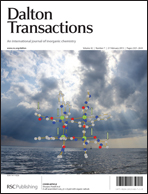The reactions of MoCl5, 1, with small amounts of a series of carbonyl compounds in a chlorinated solvent were investigated. The chloroiminium salts [ClCH![[double bond, length as m-dash]](https://www.rsc.org/images/entities/char_e001.gif) NEt2][Mo(O)Cl4{O
NEt2][Mo(O)Cl4{O![[double bond, length as m-dash]](https://www.rsc.org/images/entities/char_e001.gif) C(H)NEt2}], 2a, and [Cl
C(H)NEt2}], 2a, and [Cl![[upper bond 1 start]](https://www.rsc.org/images/entities/char_e010.gif) C
C![[double bond, length as m-dash]](https://www.rsc.org/images/entities/char_e001.gif) NH(CH2)4C
NH(CH2)4C![[upper bond 1 end]](https://www.rsc.org/images/entities/char_e011.gif) H2][Mo(O)Cl4{O
H2][Mo(O)Cl4{O![[double bond, length as m-dash]](https://www.rsc.org/images/entities/char_e001.gif)
![[upper bond 1 start]](https://www.rsc.org/images/entities/char_e010.gif) CNH(CH2)4C
CNH(CH2)4C![[upper bond 1 end]](https://www.rsc.org/images/entities/char_e011.gif) H2}], 2b, were obtained by a selective 1 : 2 molar reaction of 1 with, respectively, N,N-diethylformamide or ε-caprolactam. Otherwise 1 reacted with tetra-N-alkyl ureas in a 1 : 2 ratio to give the Mo(IV) mononuclear complexes MoCl4(urea)2 [urea = (Me2N)2CO, 3a; urea = (Et2N)2CO, 3b; urea = (EtPhN)2CO, 3c] in high yields. Addition of 2 equiv. of ketones to 1 resulted in clean formation of equimolar amounts of MoOCl3(O
H2}], 2b, were obtained by a selective 1 : 2 molar reaction of 1 with, respectively, N,N-diethylformamide or ε-caprolactam. Otherwise 1 reacted with tetra-N-alkyl ureas in a 1 : 2 ratio to give the Mo(IV) mononuclear complexes MoCl4(urea)2 [urea = (Me2N)2CO, 3a; urea = (Et2N)2CO, 3b; urea = (EtPhN)2CO, 3c] in high yields. Addition of 2 equiv. of ketones to 1 resulted in clean formation of equimolar amounts of MoOCl3(O![[double bond, length as m-dash]](https://www.rsc.org/images/entities/char_e001.gif) CR2) (R = Me, 4a; R = Et, 4b; R = Ph, 4c) and R2CCl2. Analogously 1,2-C6H4(Me)(CHCl2) was produced from MoCl5 and ortho-tolyaldehyde. The reactions of 1 with 1H-indole-2,3-dione (isatin) took place with selective chlorination of the carbonyl function non-adjacent to the nitrogen: the complexes MoOCl3(3,3-dichloro-2,3-dihydro-1H-indol-2-one)2, 5a, and MoOCl3(isatin)(3,3-dichloro-2,3-dihydro-1H-indol-2-one), 5b, were isolated depending on the stoichiometry employed. The X-ray molecular structures of 2b, 3b, 4b, 5a and 5b were ascertained.
CR2) (R = Me, 4a; R = Et, 4b; R = Ph, 4c) and R2CCl2. Analogously 1,2-C6H4(Me)(CHCl2) was produced from MoCl5 and ortho-tolyaldehyde. The reactions of 1 with 1H-indole-2,3-dione (isatin) took place with selective chlorination of the carbonyl function non-adjacent to the nitrogen: the complexes MoOCl3(3,3-dichloro-2,3-dihydro-1H-indol-2-one)2, 5a, and MoOCl3(isatin)(3,3-dichloro-2,3-dihydro-1H-indol-2-one), 5b, were isolated depending on the stoichiometry employed. The X-ray molecular structures of 2b, 3b, 4b, 5a and 5b were ascertained.
![[double bond, length as m-dash]](https://www.rsc.org/images/entities/char_e001.gif) NEt2][Mo(O)Cl4{O
NEt2][Mo(O)Cl4{O![[double bond, length as m-dash]](https://www.rsc.org/images/entities/char_e001.gif) C(H)NEt2}], 2a, and [Cl
C(H)NEt2}], 2a, and [Cl![[upper bond 1 start]](https://www.rsc.org/images/entities/char_e010.gif) C
C![[double bond, length as m-dash]](https://www.rsc.org/images/entities/char_e001.gif) NH(CH2)4C
NH(CH2)4C![[upper bond 1 end]](https://www.rsc.org/images/entities/char_e011.gif) H2][Mo(O)Cl4{O
H2][Mo(O)Cl4{O![[double bond, length as m-dash]](https://www.rsc.org/images/entities/char_e001.gif)
![[upper bond 1 start]](https://www.rsc.org/images/entities/char_e010.gif) CNH(CH2)4C
CNH(CH2)4C![[upper bond 1 end]](https://www.rsc.org/images/entities/char_e011.gif) H2}], 2b, were obtained by a selective 1 : 2 molar reaction of 1 with, respectively,
H2}], 2b, were obtained by a selective 1 : 2 molar reaction of 1 with, respectively, ![[double bond, length as m-dash]](https://www.rsc.org/images/entities/char_e001.gif) CR2) (R = Me, 4a; R = Et, 4b; R = Ph, 4c) and R2CCl2. Analogously 1,2-C6H4(Me)(CHCl2) was produced from MoCl5 and ortho-tolyaldehyde. The reactions of 1 with
CR2) (R = Me, 4a; R = Et, 4b; R = Ph, 4c) and R2CCl2. Analogously 1,2-C6H4(Me)(CHCl2) was produced from MoCl5 and ortho-tolyaldehyde. The reactions of 1 with 

 Please wait while we load your content...
Please wait while we load your content...